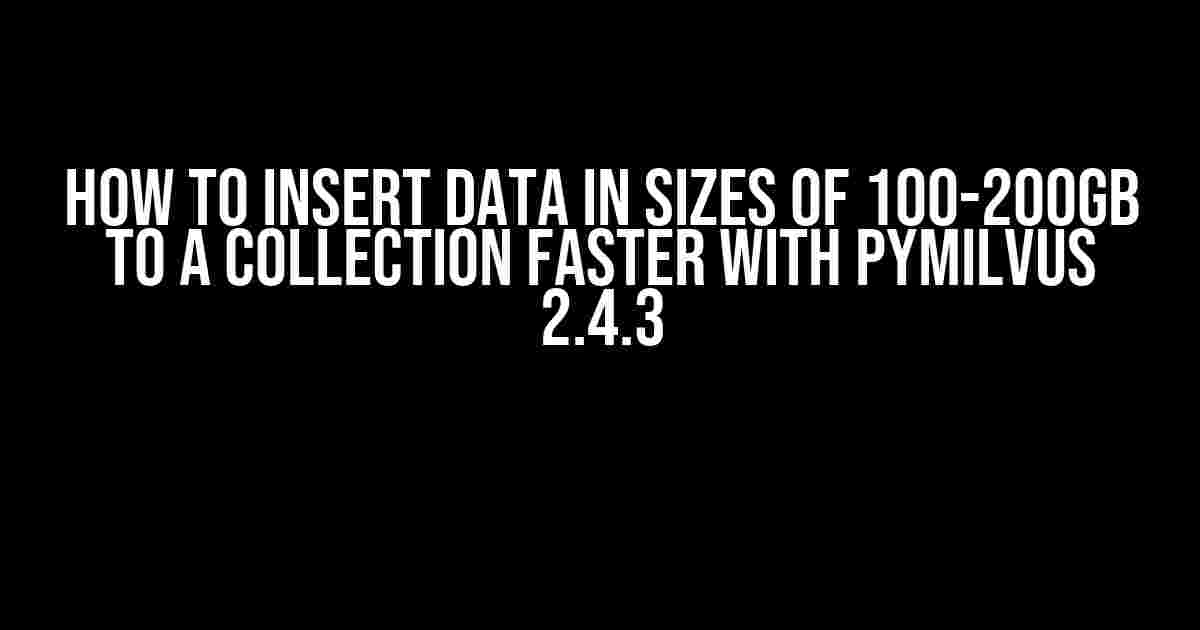Are you tired of waiting for hours to insert massive amounts of data into your Milvus collection using PyMilvus 2.4.3? Do you want to know the secrets to speeding up the data insertion process for large datasets ranging from 100-200GB? Look no further! In this comprehensive guide, we’ll dive into the best practices and optimization techniques to help you insert data at lightning-fast speeds.
Understanding the Challenges of Inserting Large Datasets
When dealing with massive datasets, inserting data into a Milvus collection can be a daunting task. The larger the dataset, the longer it takes to insert, and the more resources are consumed. This can lead to:
Memory issues: Large datasets can exceed the available memory, causing the insertion process to slow down or even fail.Network congestion: Transferring massive amounts of data over the network can lead to congestion, slowing down the insertion process.Disk I/O bottlenecks: Writing large amounts of data to disk can be slow, causing the insertion process to bottleneck.
Optimization Techniques for Faster Data Insertion
To overcome these challenges, we’ll explore the following optimization techniques to speed up data insertion for large datasets using PyMilvus 2.4.3:
1. Data Preprocessing
Before inserting data into Milvus, it’s essential to preprocess your data to reduce its size and optimize its format. This can be achieved by:
Data compression: Compressing data using algorithms like gzip or lz4 can significantly reduce its size.Data normalization: Normalizing data to a common scale can reduce memory usage and improve performance.Removing redundant data: Removing unnecessary columns or rows can reduce the overall dataset size.
2. Batch Insertion
Instead of inserting data one row at a time, batching multiple rows together can significantly improve performance. PyMilvus 2.4.3 provides the insert method, which accepts a list of entities to be inserted in a single operation.
entities = [...list of entities to be inserted...]
milvus.insert(entities)3. Paralleling Insertion
Take advantage of multiple CPU cores by paralleling the insertion process using Python’s concurrent.futures module.
import concurrent.futures
def insertEntities(entities):
milvus.insert(entities)
entities_list = [...list of entities to be inserted, split into batches...]
with concurrent.futures.ThreadPoolExecutor(max_workers=5) as executor:
futures = [executor.submit(insertEntities, batch) for batch in entities_list]
for future in concurrent.futures.as_completed(futures):
future.result()4. Optimizing Milvus Configuration
Adjusting Milvus configuration can significantly impact performance. Consider:
Increasing the write buffer size: This can improve performance by reducing the number of write operations.Tuning the flush interval: Adjusting the flush interval can help avoid frequent disk I/O operations.Configuring the log level: Reducing the log level can minimize overhead and improve performance.
5. Distributed Insertion
For extremely large datasets, consider distributing the insertion process across multiple machines using PyMilvus 2.4.3’s built-in support for distributed Milvus clusters.
from pymilvus import Milvus, DataType
milvus = Milvus(host="localhost", port=19530)
# Create a distributed Milvus cluster
milvus.create_collection(
"my_collection",
fields=[
{"name": "id", "dtype": DataType.INT64},
{"name": "vector", "dtype": DataType.FLOAT_VECTOR, "dim": 128}
],
shards_num=2,
segmentation={"type": "hash"}
)
# Insert data in parallel across the distributed cluster
milvus.insert(entities, parallel=True)Putting it All Together
By combining these optimization techniques, you can significantly improve the speed of inserting large datasets into a Milvus collection using PyMilvus 2.4.3. Remember to:
- Preprocess your data to reduce its size and optimize its format.
- Use batch insertion to reduce the number of write operations.
- Parallelize the insertion process using multiple CPU cores.
- Optimize Milvus configuration for better performance.
- Consider distributing the insertion process across multiple machines for extremely large datasets.
Conclusion
Inserting large datasets into a Milvus collection using PyMilvus 2.4.3 doesn’t have to be a tedious and time-consuming process. By applying these optimization techniques, you can significantly improve performance and reduce the time it takes to insert massive amounts of data. Remember to experiment with different techniques and configurations to find the optimal approach for your specific use case.
| Technique | Benefits |
|---|---|
| Data Preprocessing | Reduced memory usage, improved performance |
| Batch Insertion | Improved performance, reduced number of write operations |
| Paralleling Insertion | Improved performance, better CPU utilization |
| Optimizing Milvus Configuration | Improved performance, reduced overhead |
| Distributed Insertion | Improved performance, scalability for extremely large datasets |
Start optimizing your data insertion process today and experience the power of PyMilvus 2.4.3!
Frequently Asked Question
Want to know the secret to inserting large amounts of data into a collection at lightning-fast speeds? We’ve got you covered! Check out these frequently asked questions on how to insert data in sizes of 100-200GB to a collection faster using pymilvus 2.4.3.
What’s the optimal way to insert large datasets into a collection?
To insert large datasets, use the `insert` method in batches. Break down your dataset into smaller chunks, and insert each chunk separately. This approach helps to avoid memory issues and ensures faster insertion speeds. You can also consider using parallel insertion with multiple threads or processes to further boost performance.
How can I optimize my data structure for faster insertion?
Optimize your data structure by using a compact data format, such as NumPy arrays or pandas DataFrames, which can be efficiently serialized and deserialized. Additionally, consider using a column-oriented storage format, like Apache Parquet, to reduce data size and improve insertion speeds.
What’s the role of caching in improving insertion performance?
Caching can significantly improve insertion performance by reducing the time it takes to access and write data to the collection. Enable caching in your pymilvus client and configure the cache size to optimize performance. This will help reduce the number of write operations and improve overall insertion speeds.
Are there any specific pymilvus configuration settings that can help with large inserts?
Yes, there are several pymilvus configuration settings that can help with large inserts. For example, you can increase the `bulk_size` parameter to insert larger batches of data at once, or adjust the ` timeout` parameter to allow for longer insertion times. Experiment with different settings to find the optimal configuration for your use case.
What are some best practices for monitoring and troubleshooting large inserts?
To monitor and troubleshoot large inserts, use metrics and logging to track insertion progress, error rates, and performance metrics. Enable debug logging in your pymilvus client to get detailed insights into the insertion process. Additionally, use tools like Prometheus and Grafana to monitor Milvus cluster performance and identify bottlenecks.


